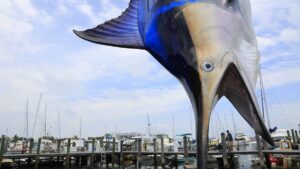Dr Boreham’s Crucible: Opthea needs some big licks of dough, but it has set itself up for success

Pic: Charnchai / iStock / Getty Images Plus via Getty Images
Coming after trial flops from Factor Therapeutics (ASX:FTT), Innate Immunotherapeutics (now Amplia Therapeutics, ASX:ATX) and Bionomics (ASX:BNO), investors were awaiting the phase IIb results from the eye diseases house with more than a degree of trepidation.
They need not have fretted. Like Australian footy’s OPSM (Optical Prescription Spectacle Makers) sponsored umpires, biotech’s greater powers have a habit of evening up the score.
Released on August 7, Opthea’s (ASX:OPT) results for its OPT-302 combination treatment for wet age-related macular degeneration (wet ADM) were shown to be “statistically significant and clinically meaningful”, opening up the prospect for a new drug for this hard-to-treat yet common affliction.
Opthea stock then closed 138 percent higher on the day at $2.06 a share, ascribing a $500m valuation to the company.
But the buyers weren’t done yet, with the shares closing the week at $2.79 for a chunky market cap of close to $700m.
Reflecting the extraordinary interest, 160 listeners dialled-in to the company’s conference call on the morning of the announcement.
“There were a lot of eyes on it,” says Opthea CEO Dr Megan Baldwin (pun unintended, presumably).
Given the global trial cost $40m, a negative or ambiguous outcome would have met with a markedly different reaction.
Of course, there’s still much work to do. A phase III trial awaits and management is wasting no time approaching regulators to set the parameters for these studies.
So, what is wet age-related macular degeneration?
Wet AMD is marked by loss of vision caused by degeneration of the central portion of the retina (the macula). Blood vessels grow abnormally under the retina, resulting in leakage of fluid and protein from the vessel.
“It happens really quickly. Patients can see one week and then 10 days later lose their vision,” Baldwin says.
A so-called trap inhibitor, OPT-302 is a fusion protein that blocks the activity of two proteins, vascular endothelial growth factors C and D (VEGF-C and VEGF-D).
Opthea is developing OPT-302 as a combination therapy with the existing drugs Lucentis and Eylea, which block VEGF-A
“There’s a good understanding of the product, which validates our approach of targeting difficult pathways,” Baldwin says.
About the trial
The trial, enrolling 366 previously untreated patients across 110 sites, aimed to test a combination of Opthea’s OPT-302 with the standard of care therapy, ranibizumab, marketed as Lucentis.
Relative to the control group treated only with ranibizumab, the randomised, double masked, sham-controlled trial showed a mean “visual acuity gain” after 24 months.
Randomised means the patients were split, like, randomly into four groups: those receiving OPT-302 and ranibizumab in a 0.5mg dose, ditto for 2.0mg, a sham injection in combo with ranibizumab and ranibizumab alone.
In lay folk terms, the lucky-duck OPT-302 with ranibizumab patients were able to read more letters on an eye chart: a mean 14.2 letters compared with 10.8 letters for the ranibizumab-only control group.
The result achieved a probability (“p”) score of 0.0107, bearing in mind that the closer to zero the less chance the results were a fluke, meaning that the result was 98.93 per cent not just good luck.
Patients were treated with two intra-vitreal (injected) doses of 0.5mg and 2.0mg, with the low dose group having a similar result to the control group.
The primary endpoint was a “mean change” in visual acuity, as measured by the official standard known as the Early Treatment Diabetic Retinopathy Study (ETDRS) best corrected visual acuity (BCVA), also known as a standard eye chart.
Opthea also claims victory with key secondary endpoints, including the proportion of participants gaining 15 or more letters on an eye chart.
Of those in the 2.0mg combo cohort, 45 percent gained 15 letters or more from the baseline, compared with 40.5 per cent in the Lucentis only group.
Also, 99.2 percent of the 2.0mg combo group achieved stable vision – defined as loss of fewer than 15 letters – compared with 96.7 per cent for the Lucentis only group.
‘A high bar’
Chief investigator and ophthalmic surgeon at King’s College London, Professor Tim Jackson, said the bar was set high in terms of the trial’s construction.
“OPT-32 may emerge as a combination treatment that can offer better vision gains than the standard of care,” Jackson enthuses.
“Further registrational trials are clearly justified.”
Baldwin said the trial could have been constructed as a phase III registration trial !!!, but would have required dosing results for nine to 12 months and more safety data, which would have taken too much time.
The design of the trial, she said, posed sizeable hurdles.
“With two injections you have to be better [than the standard of care]. You can’t be equivalent and that’s why we went to the trial we did,” she said.
Baldwin said the trial was one of the biggest phase IIb studies ever carried out and was done under “tight” conditions with the masking of data.
“We didn’t know the result until we got the email,” she said.
What’s next?
Not surprisingly, the company is planning its phase III trial, having already knocked on the door of European regulators to suss out what is required. The US FDA is next.
“We are doing all we can,” Baldwin says. “You don’t want to waste any time on a trial program, because time is money.”
While the structure of the phase III study is undecided, it’s likely to involve two trials of about 400 patients each, randomised to a control arm and a 2.0mg dosing arm.
The trial will “take all comers” rather than focus on patient sub-groups, thus expanding the indication of any commercialised product.
Meanwhile, Opthea is enrolling a targeted 108 patients for a phase IIa trial to test a combination of OPT-302 and aflibercept (marketed as Eylea) on untreated diabetic macular oedema (DME).
A smaller nine-patient, phase Ib effort met safety hurdles in July 2018.
The phase IIa study is being carried out at sites in the US, Israel, Latvia and Australia.
The primary endpoint is a five-letter improvement after week 12, relative to the Eylea-only control group.
Affecting a younger, working age demographic, DME is a blindness-inducing condition that also involves retinal leakage. DME flows from diabetic retinopathy, which damages blood vessels in the retina to leak fluid.
The wet AMD market is about twice as big as the DME market, but both are commercially attractive indications.
Finances and performance
As of results, Opthea had $20m in cash and expects $14m of Federal Research and Development Tax Incentive to roll in by the end of the year.
The company is fully funded for phase IIb trial close-out activities and the ongoing DME trial.
Opthea has enough money to “prepare for registrational phase III trial activities”.
As for the phase III trial itself, the company won’t see much change out of $150m or so and all financing options – including partnerships – are on the table.
Opthea last went to the equity funding well in April 2017, raising $45m after initial positive phase I wet AMD results.
Opthea also raised $13.3m from in-the-money options in November 2014.
Unusually, recruitment for the wet AMD trial was completed six months early, which meant the results could be pulled forward from their scheduled 2020 release.
“The recruitment was phenomenal, which really helped our case,” Baldwin says. “We now have more [funding] runway than what we thought.”
Fun fact
Opthea is the renamed iteration of Circadian Technologies, which is – or was – the first ASX-listed biotech, founded by biotech doyen Leon Serry and at one time including as a shareholder, Dr Alan Finkel, now Australia’s chief scientist.
Circadian was “an incubator” for companies including the Victoria state-founded Amrad, later renamed Zenyth and sold to CSL.
Other companies in its portfolio were Metabolic (which became Calzada before morphing into Polynovo), Antisense and Optiscan, with Serry helping establish Finkel’s Axon Instruments.
Circadian dabbled in a number of applications including melatonin for jet-lag (hence the name), drugs for Alzheimer’s and cancer diagnostics before deciding to focus on eye ailments. It acquired the VEGF portfolio a moment ago in biotech terms – in 2008.
Dr Boreham’s diagnosis:
Opthea’s diabetic macular oedema phase IIa results are expected in early 2020. Otherwise there may be a lull as the company does the dull but important stuff of parading the results at global ophthalmology conferences, such as EU Retina held in Paris on September 8 and an American Academy of Ophthalmology confab on October 12, 2019.
There’s also the arcane ritual of being published in learned peer journals.
The company notes that global sales of Lucentis and Eyelea last year were worth $US3.7 billion and $US6.2 billion respectively – and these can only treat about one-third of the wet ADM sufferers.
The cancer drug Avastin, used as an off-label cheaper alternative, accounts for even more than that.
In essence, that is what’s got the market hares running post last week’s trial results.
While Opthea needs some big licks of dough to fund the phase III trial, at least it’s in a position of strength.
“If you come from the basis of success you have many options, whether it’s funding or partnering,” says chairman Geoff Kempler.
- Subscribe to our daily newsletter
- Join our small cap Facebook group
- Follow us on Facebook or Twitter
Despite the price surge, major investors have been happy to buy at the elevated valuation.
When Dr Boreham last opined on Opthea back in April 2017, he said: “While it’s nice to see Opthea with a sharp focus on the one drug, there’s little for the company to fall back on if OPT-302 fails to shine.”
He added the market would wait and “see” and, indeed we now all have seen the light on this one.
Disclosure: Dr Boreham is not a qualified medical practitioner and does not possess a doctorate of any sort. But he likes to think of himself as a man of vision with his eyes firmly on the big picture.
This column first appeared in Biotech Daily.
The content of this article was not selected, modified or otherwise controlled by Stockhead. Stockhead has not provided, endorsed or otherwise assumed responsibility for any financial product advice contained in this article.
UNLOCK INSIGHTS
Discover the untold stories of emerging ASX stocks.
Daily news and expert analysis, it's free to subscribe.
By proceeding, you confirm you understand that we handle personal information in accordance with our Privacy Policy.








